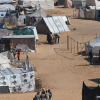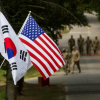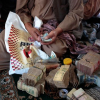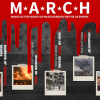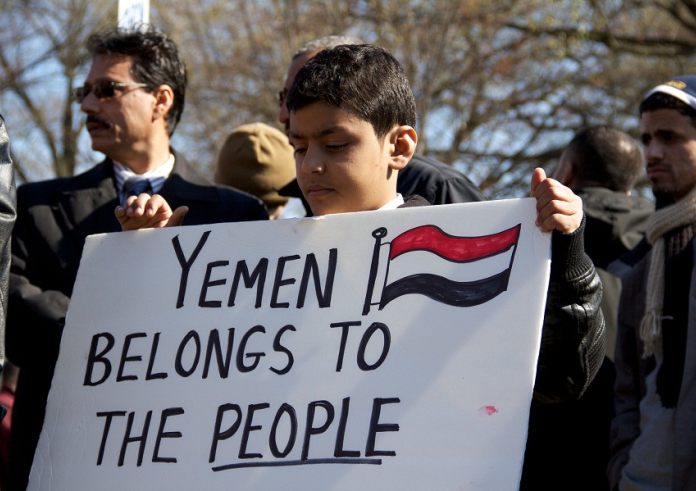
Twenty years ago this month, US president George W Bush offered the first hints of an impending attack on Saddam Hussein's Iraq during an address to the United Nations General Assembly.
Mr Bush's speech on September 12 initially focused on the “war on terror” and efforts to combat poverty, but much of his address made a case for action against Iraq, outlining how the US believed Saddam was making strides towards developing weapons of mass destruction and collaborating with terrorist groups.
Implying the US would rally nations to use “decisive force”, Mr Bush said the “United States would support political and economic liberty in a unified Iraq”.
However, US efforts to support this “political and economic liberty” were doomed to fail, according to veterans of the war who spoke to The National. Meetings held since August to discuss action in Iraq were dominated by military planning rather than ways to rebuild and stabilise the country, they said.

A week before Mr Bush's UN speech, top US General Tommy Franks held one of many meetings with Mr Bush and the US National Security Council. The man charged with planning the invasion was reportedly asked by the president, “can we win this thing?”
“Of course,” Gen Franks replied.
Militarily, it was a fair assumption — the US assessed that the Iraqi army had little will to fight and was on the edge of collapse, recovering from decades of conflict and tough sanctions.
Through August, military planning assumptions had been made, including that the “Iraqi regime has WMD capability”, that regional states would not “oppose the US with conventional forces” and that “opposition groups will work with us”.
These “key planning assumptions”, listed on a PowerPoint slide of the same name, illustrate the focus on military operations rather than post conflict events — what the military sometimes refers to as Phase IV operations.

“False and bad assumptions lead to a flawed plan and lead to a lack of strategy for phase four,” retired Lt Gen Michael Barbero told The National.
Lt Gen Barbero was the assistant division commander to the US 4th infantry division in 2003 and went on to lead the training effort for the Iraqi army between 2009 and 2011.
But after the invasion, not all “opposition groups” worked with the US — Iraq’s Shiite nationalist Sadrist movement, for example, fought a bloody insurgency against the US-led coalition, helping to turn southern Iraq into a quagmire of violence.
Mainstream political parties in the new Iraq also received backing from businessmen and organisations hostile to the US.
Likewise, while regional states may not have opposed the US with “conventional forces” — as predicted — insurgents and funding for them flooded into Iraq from countries such as Iran and Syria.
Failed reconstruction
Most historians agree that reconstruction planning was sidelined by Mr Bush's secretary of defence Donald Rumsfeld, who failed to foresee insurgency and civil war that would lead to hundreds of thousands of Iraqi deaths.
“I'm not sure Rumsfeld paid any attention to any warnings about the war. He was nitpicking at all the details and going through deployment orders, for example. He missed the forest for the trees,” says Joel Wing, a researcher who has interviewed more than 100 key figures involved in the conflict.
Mr Wing says Rumsfeld overlooked growing concern in parts of the US government that the war could be a disaster.
“The Bush administration denied planners [of all agencies] the opportunity to plan for Phase IV because it would have gone contrary to their promises of a quick war and exit,” says retired Lt Col Craig Whiteside, whose battalion was deployed in Babil, a province that was torn by sectarian violence.
“Both were delusional predictions, but the politics prevented them from allowing the planning. I’ve had senior diplomats tell me this — [the] State [Department] was completely cut out and deemed untrustworthy messengers of a quick and easy war.”
The perfect storm
Despite being sidelined from the planning, the State Department was making its own assessments, including a chilling July 2002 report that warned of “a horrible wave of bloodletting,” as those oppressed by Saddam sought revenge, and that a new Iraqi army and US forces could be powerless to stop the violence.
The report, titled “The Perfect Storm”, also warned that a large US force would be needed if chaos took hold.
But Rumsfeld spent 2002 pressing Gen Franks to use as few US troops as possible, at one point suggesting Saddam could be toppled with just 5,000 troops.
For Rumsfeld, removing Saddam was a “hard power” problem and would not entail what the Bush administration derisively called “nation building”.
A small invasion force “would have risked having American units wiped out by capable Iraqi forces. Mass has always been a principle of war. Rumsfeld had no military training and is lucky his military officers pushed back on a delusional plan,” Lt Col Whiteside says.
“But even then, we had far from enough forces.”
Initial US plans in mid-2002 envisaged just two to three months of “stabilising” Iraq in the Phase IV part of the campaign.

But Rumsfeld was assured the military outcome was not in question. That was also the view of Ismael Alsodani, an Iraqi regimental commander in Kirkuk in September 2002.
“For military units, we were operating at almost 50 per cent of our capability, in terms of equipment, personnel and logistics. So the army itself was not prepared well for this war. We were looking at maybe Saddam having some reserves like the Republican Guards,” he says, referring to what historians say were the country’s best soldiers.
“But we can't compare Iraqi military capabilities with the coalition capabilities, because we had a very bitter experience during the first Gulf War in Kuwait,” he says.
The lopsided, US-led victory in the 1991 conflict shaped Rumsfeld’s view of overwhelming US power which could reshape nations, what he called a “military-technological revolution in warfare”.
Lt Gen Barbero has clear memories of detailed discussions on force levels during briefings in 2002, where he says planning was “based on a conventional fight into Baghdad, with very little if any discussion of a phase four, or a postwar insurgency. You had these competing personalities and all these different competing factions in Washington.”
He says Rumsfeld continually rejected higher troop numbers that were desperately needed to protect vital infrastructure from looters and insurgents, as well as to protect their own forces.
“He didn't want to do it, even into 2006, he still didn't want to send more forces in there. So that was his ‘going in’ position. And he was very turf conscious. So a lot of that had to do with the personalities involved. His being, I think, the strongest one, which was totally counterproductive.”
Bad intelligence
Ominously, Gen Franks remarked in his September 6 meeting with Bush that the US military had little intelligence on where Iraqi Scud missiles were — weapons that the US wrongly assumed could be fitted with WMDs.
This lack of information pointed to a deeper problem, a lack of reliable “human intelligence”, or humint in military jargon, something Lt Gen Barbero blames on “an over-reliance on expats”, in the Iraqi opposition who were involved in plans — and promises — about a stable postwar Iraq.
This, he says, falls under “intelligence preparation of the battlefield”, a vital step in successful planning.
Beyond the military PowerPoint briefings through 2002, there had long been warnings of what lay in wait if Saddam was removed.
Alarms were raised by the 1999 Desert Crossing war games — military and civilian exercises looking at what would happen in the event of regime change.
The exercises warned that “US involvement in Iraq may lead Iran to prevent the establishment of a ‘hostile’ government”. In the event, Tehran did back militias that were responsible for the deaths of at least 600 US soldiers and injuries to thousands, as well as groups opposed to Iraqi democracy.
Desert Crossing also warned of “aggressive neighbours, fragmentation along ethnic and religious lines and chaos created by rival forces bidding for power”, all of which came to pass as US-led forces found themselves in the middle of a civil war.
Cultural differences
“They didn't know about Shia or Sunni. They have an idea about Iraq. They know Babylon. They know the Euphrates. They know Baghdad, they know Saddam Hussein. But their mission is to destroy their enemy,” says Kadhim Al Waeli, an Iraqi who assisted the US 101st Airborne Division as they took control of his home town, Najaf.
Mr Al Waeli, part of an Iraqi auxiliary force known as the Free Iraqi Forces, was described by his colleague, Col Chris Hughes, as his most vital resource during the invasion, when Americans soon found themselves confronted with a complex society, factionalised by decades of conflict and oppression.
As US forces battled Baathists in Najaf, Mr Al Waeli was quick to point out to Col Hughes the value of not damaging holy sites and holding fire during the call to prayer, and became his key interlocutor.
Their work together would later be used as a case study in a US military training manual.
But despite the initial success of US forces in building local allies in Najaf — something that was also briefly achieved in Mosul — Mr Al Waeli said the US was not prepared for how hostile Iraqi society had become after 35 years of dictatorship.
There was “a propaganda campaign against America and the West. For Iran, the Great Satan. The Baathists looked to America as the imperialist, and everyone thinks ‘America well, they they're here to change our culture, our religion.' And that's the resistance starting from the Shia side.
“Of course, the Sunnis resisted because they lost power,” he adds.
“Hope started fading away,” Mr Al Sodani says, after Saddam's fall.
“We were hoping the Americans could rebuild the country and change the mentality of Iraqis to accept democracy, because we had been under Saddam for almost three decades,” he says.
But this would not come to pass. “The Americans built their strategy on misinformation, or on information from people who haven't been to Iraq.”
Source: MENA







